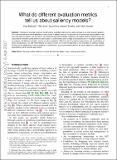What Do Different Evaluation Metrics Tell Us About Saliency Models?
Author(s)
Bylinskii, Zoya; Judd, Tilke; Oliva, Aude; Torralba, Antonio; Durand, Frederic
DownloadSubmitted version (6.078Mb)
Terms of use
Metadata
Show full item recordAbstract
How best to evaluate a saliency model's ability to predict where humans look in images is an open research question. The choice of evaluation metric depends on how saliency is defined and how the ground truth is represented. Metrics differ in how they rank saliency models, and this results from how false positives and false negatives are treated, whether viewing biases are accounted for, whether spatial deviations are factored in, and how the saliency maps are pre-processed. In this paper, we provide an analysis of 8 different evaluation metrics and their properties. With the help of systematic experiments and visualizations of metric computations, we add interpretability to saliency scores and more transparency to the evaluation of saliency models. Building off the differences in metric properties and behaviors, we make recommendations for metric selections under specific assumptions and for specific applications.
Date issued
2019-03Department
Massachusetts Institute of Technology. Computer Science and Artificial Intelligence Laboratory; Massachusetts Institute of Technology. Department of Electrical Engineering and Computer ScienceJournal
IEEE Transactions on Pattern Analysis and Machine Intelligence
Publisher
Institute of Electrical and Electronics Engineers (IEEE)
Citation
Bylinskii, Zoya et al. "What Do Different Evaluation Metrics Tell Us About Saliency Models?" IEEE Transactions on Pattern Analysis and Machine Intelligence 41, 3 (March 2019): 740 - 757 © 2019 IEEE
Version: Original manuscript
ISSN
0162-8828
2160-9292
1939-3539
